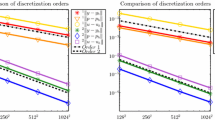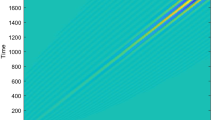Abstract
This paper is concerned with a bilinear control problem for enhancing convection-cooling via an incompressible velocity field. Both optimal open-loop control and closed-loop feedback control designs are addressed. First and second order optimality conditions for characterizing the optimal solution are discussed. In particular, the method of instantaneous control is applied to establish the feedback laws. Moreover, the construction of feedback laws is also investigated by directly utilizing the optimality system with appropriate numerical discretization schemes. Computationally, it is much easier to implement the closed-loop feedback control than the optimal open-loop control, as the latter requires to solve the state equations forward in time, coupled with the adjoint equations backward in time together with a nonlinear optimality condition. Rigorous analysis and numerical experiments are presented to demonstrate our ideas and validate the efficacy of the control designs.







Similar content being viewed by others
References
Barbu, V., Marinoschi, G.: An optimal control approach to the optical flow problem. Syst. Control Lett. 87, 1–9 (2016)
Bejan, A.: Convection Heat Transfer (2013). Wiley, Hoboken
Bewley, T.R., Moin, P., Temam, R.: DNS-based predictive control of turbulence: an optimal benchmark for feedback algorithms. J. Fluid Mech. 447(2), 179–225 (2001)
Bergman, T.L., Incropera, F.P., Lavine, A.S., DeWitt, D.P.: Introduction to Heat Transfer. Wiley, Hoboken (2011)
Burns, J.A., Cliff, E.M.: Numerical methods for optimal control of heat exchangers. In: Proceedings 2014 American Control Conference, pp. 1649–1654 (2014)
Burns, J.A., Kramer, B.: Full flux models for optimization and control of heat exchangers. In: Proceedings of American Control Conference (ACC), pp. 577–582. IEEE (2015)
Calcagni, B., Marsili, F., Paroncini, M.: Natural convective heat transfer in square enclosures heated from below. Appl. Therm. Eng. 25(16), 2522–2531 (2005)
Chang, Y., Collis, S.S.: Active control of turbulent channel flows based on large eddy simulation. In: Proceedings of the FEDSM99. ASME, vol. 6929, pp. 1–8 (1999)
Chen, G., Fu, G., Singler, J., Zhang, Y.: A class of embedded DG methods for Dirichlet boundary control of convection diffusion PDEs. J. Sci. Comput. 81, 623 (2019)
Chen, G., Singler, J., Zhang, Y.: An HDG method for Dirichlet boundary control of convection dominated diffusion PDEs. SIAM J. Numer. Anal. 57(4), 1919–1946 (2019)
Chen, G., Hu, W., Shen, J., Singler, J., Zhang, Y., Zheng, X.: An HDG method for distributed control of convection diffusion PDEs. J. Comput. Appl. Math. 343, 643–661 (2018)
Choi, H., Temam, R., Moin, P., Kim, J.: Feedback control for unsteady flow and its application to the stochastic Burgers equation. J. Fluid Mech. 253, 509–543 (1993)
Choi, Y.: Suboptimal control of turbulent flow using control theory. In: Proceedings of the International Symposium on Mathematical Modelling of Turbulent Flows, Tokyo, Japan (1995)
Choi, H., Hinze, M., Kunisch, K.: Instantaneous control of backward-facing step flows. Appl. Numer. Math. 31(2), 133–158 (1999)
Constantin, P., Foias, C.: Navier-Stokes Equations. University of Chicago Press, Chicago (1988)
Constantin, P., Kiselev, A., Ryzhik, L., Zlatoš, A.: Diffusion and mixing in fluid flow. Ann. Math. 168, 643–674 (2008)
Corcione, M.: Effects of the thermal boundary conditions at the sidewalls upon natural convection in rectangular enclosures heated from below and cooled from above. Int. J. Therm. Sci. 42(2), 199–208 (2003)
Dalal, A., Das, M.K.: Natural convection in a rectangular cavity heated from below and uniformly cooled from the top and both sides. Numer. Heat Transf. A 49(3), 301–322 (2006)
Dede’, L., Quarteroni, A.: Optimal control and numerical adaptivity for advection-diffusion equations. ESAIM 39(5), 1019–1040 (2005)
Evans, L.C.: Partial Differential Equations, Vol. 19 of Graduate Studies in Mathematics. American Mathematical Soc, Providence (2010)
Foias, C., Manley, O., Rosa, R., Temam, R.: Navier-Stokes Equations and Turbulence, vol. 83. Cambridge University Press, Cambridge (2001)
Garcia, C.E., Prett, D.M., Morari, M.: Model predictive control: theory and practice-a survey. Automatica 25(3), 335–348 (1989)
Glowinski, R., Song, Y., Yuan, X., Yue, H.: Bilinear optimal control of an advection-reaction-diffusion system. arXiv:2101.02629
Gong, W., Hu, W., Mateos, M., Singler, J., Zhang, X., Zhang, Y.: A new HDG method for Dirichlet boundary control of convection diffusion PDEs II: Low regularity. SIAM J. Numer. Anal. 56(4), 2262–2287 (2018)
Hinze, M., Kunish, K.: Control strategies for fluid flows-optimal versus suboptimal control. In: Bock H.G., et al. (eds.) ENUMATH 97, pp. 351–358 (1997)
Hinze, M.: Optimal and instantaneous control of the instationary Navier-Stokes equations, (2000), Citeseer
Hinze, M., Kunisch, K.: Three control methods for time-dependent fluid flow. Flow Turbul. Combust. 65(3), 273–298 (2000)
Hinze, M., Volkwein, S.: Analysis of instantaneous control for the Burgers equation. Nonlinear Anal. 50(1), 1–26 (2002)
Hu, W.: Enhancement of heat transfer in stokes flows. In: Proceedings of the 56th IEEE Conference on Decision and Control, pp. 59–63 (2017)
Hu, W., San, O.: Optimal control of heat transfer in unsteady stokes flows. In: 2018 IEEE Conference on Decision and Control (CDC), pp. 3752–3757 (2018)
Hu, W.: Boundary control for optimal mixing by Stokes flows. Appl. Math. Optim. 78(1), 201–217 (2018)
Hu, W., Wu, J.: Boundary Control for Optimal Mixing via Navier-Stokes Flows. SIAM J. Control. Optim. 56(4), 2768–2801 (2018)
Hu, W.: An approximating control design for optimal mixing by Stokes flows. Appl. Math. Optim. 82, 471–498 (2020)
Hu, W., Wu, J.: An approximating approach for boundary control of optimal mixing via Navier-Stokes flows. J. Differ. Equ. 267(10), 5809–5850 (2019)
He, C., Hu, W., Mu, L.: Optimal control of convection-cooling and numerical implementation. Comput. Math. Appl
Kunisch, K., Lu, X.: Optimal control for multi-phase fluid Stokes problems. Nonlinear Anal. 74(2), 585–599 (2011)
Kreith, F., Manglik, R.M., Bohn, M.S.: Principles of Heat Transfer. Cengage Learning, Stamford (2012)
Lee, C., Kim, J., Choi, H.: Suboptimal control of turbulent channel flow for drag reduction. J. Fluid Mech. 358, 245–258 (1998)
Lions, J.-L.: Optimal Control of Systems Governed by Partial Differential Equations. Springer, New York (1971)
Lin, Z., Thiffeault, J.-L., Doering, C.R.: Optimal stirring strategies for passive scalar mixing. J. Fluid Mech. 675, 465–476 (2011)
Lunasin, E., Lin, Z., Novikov, A., Mazzucato, A., Doering, C.R.: Optimal mixing and optimal stirring for fixed energy, fixed power, or fixed palenstrophy flows. J. Math. Phys. 53(11), 115611 (2012)
Liu, W.: Mixing enhancement by optimal flow advection. SIAM J. Control. Optim. 47(2), 624–638 (2008)
Mathew, G., Mezić, I., Petzold, L.: A multiscale measure for mixing. Physica D 211(1), 23–46 (2005)
Mathew, G., Mezić, I., Grivopoulos, S., Vaidya, U., Petzold, L.: Optimal control of mixing in Stokes fluid flows. J. Fluid Mech. 580(1), 261–281 (2007)
Min, C., Choi, H.: Suboptimal feedback control of vortex shedding at low Reynolds numbers. J. Fluid Mech. 401, 123–156 (1999)
Nevistic, V., Primbs, J.A.: Finite receding horizon control: a general framework for stability and performance analysis, preprint (1997)
Rawlings, J.B., Muske, K.R.: The stability of constrained receding horizon control. IEEE Trans. Autom. Control 38(10), 1512–1516 (1993)
Sezai, I., Mohamad, A.A.: Natural convection in a rectangular cavity heated from below and cooled from top as well as the sides. Phys. Fluids 12(2), 432–443 (2000)
Stampacchia, G.: Le problème de Dirichlet pour les équations elliptiques du second ordre à coefficients discontinus. Annales de l’institut Fourier 15(1), 189–257 (1965)
Temam, R.: Navier–Stokes equations and nonlinear functional analysis. SIAM (1995)
Temam, R.: Navier-Stokes Equations, Theory and Numerical Analysis, Studies in Mathematics and Its Applications, Vol. 2, North-Holland
Thiffeault, J.-L.: Using multiscale norms to quantify mixing and transport. Nonlinearity 25(2), R1 (2012)
Unger, A., Tröltzsch, F.: Fast solution of optimal control problems in the selective cooling of steel. ZAMM-J. Appl. Math. Mech./Zeitschrift für Angewandte Mathematik und Mechanik 81(7), 447–456 (2001)
Walker, H.F., Ni, P.: Anderson acceleration for fixed-point iterations. SIAM J. Numer. Anal. 49(4), 1715–1735 (2011)
Acknowledgements
W. Hu was partially supported by the NSF Grants DMS-1813570 and DMS-2111486.
Author information
Authors and Affiliations
Corresponding author
Additional information
Publisher's Note
Springer Nature remains neutral with regard to jurisdictional claims in published maps and institutional affiliations.
Appendix
Appendix
Proof of Corollary 2.5
Without loss of generality, we assume that \(\langle T_0\rangle =0\). First, using the optimality condition (2.25) together with (2.8) and (2.27), we get
Moreover, by (2.14) and (2.27) we have
To obtain a higher regularity of T, we take the inner product of (2.20) with \((-\Delta )^2T\) and get
This follows
where we used Agmon’s inequality (3.32) in the last inequality. Therefore, applying (5.1) to (5.3) yields
and
This completes the proof. \(\square \)
Proof of Theorem 2.6
Let \(h_i\in U_{\text {ad}}\) and \(z_i=T'({\mathbf {v}})\cdot h_i, i=1,2\). Then we have
In light of Corollary 2.5, we can also obtain a higher regularity of \(z_i, i=1,2,\) than (2.19). To see this, taking the inner produce of (5.6) with \(-\Delta z_i\) and noting that \(\langle z_i\rangle =0\) by (2.18), we obtain
Thus
where by (5.4),
Consequently,
and
Next, let \(Z=z'_1({\mathbf {v}})\cdot h_2\). Then Z satisfies
and \(\langle Z\rangle =0\). Applying an \(L^2\)-estimate for Z gives
which, together with (5.8), follows
Therefore,
By Lemma 2.2, (2.19) and (5.10), it can be easily verified that the terms on the right hand side of (5.9) are all in \(L^1(0, t_f; (H^{1}(\Omega ))')\), and hence \( \frac{\partial Z}{\partial t} \in L^1(0, t_f; (H^{1}(\Omega ))')\). Thus there exists a unique solution to (5.9), which implies that \(T({\mathbf {v}})\) is twice G\({\hat{a}}\)teaux differentiable at \({\mathbf {v}}\in U_{\text {ad}}\) satisfying the optimality condition (2.22), with respect to \(h_1\) and \(h_2\), so is \(J({\mathbf {v}})\).
Now differentiating \(J'({\mathbf {v}})\cdot h_1\) once again in the direction \(h_2\in U_{\text {ad}}\) gives
Next taking the inner product of (5.9) with q and applying (2.3), we get
With the help of the adjoint equations (2.21), we obtain
Therefore, (5.11) becomes
Setting \(h_1=h_2=h\) and \(z_1=z_2=z=T'({\mathbf {v}})\cdot h\) follows
Furthermore, by (2.1), (2.19), (2.26) and (5.8), we get
and
As a result,
and
Therefore, letting \(\gamma \) large enough such that
we obtain (2.29). \(\square \)
Remark 5.1
For \(T_0\in L^2(\Omega )\) and \({\mathbf {v}}\in L^2(0, \infty ; H)\), \(\Vert DT\Vert _{L^2}\) obeys an exponential decay rate in time.
Proof
Taking the inner product of (1.1) with \(D^*DT\) and applying Greens’ formula and (2.3), we have
Since \(\langle T\rangle =\langle T_0\rangle \) and \(D^*D=D\), we have \(\nabla (D^*DT) =\nabla (DT) =\nabla (T-\langle T\rangle )=\nabla T,\) and hence using Stokes formula follows
Therefore, (5.14) becomes
Further applying Grönwall’s inequality and Poincaré inequality we derive that
which establishes the claim. \(\square \)
Rights and permissions
About this article
Cite this article
Hu, W., Liu, J. & Wang, Z. Bilinear Control of Convection-Cooling: From Open-Loop to Closed-Loop. Appl Math Optim 86, 5 (2022). https://doi.org/10.1007/s00245-022-09876-x
Accepted:
Published:
DOI: https://doi.org/10.1007/s00245-022-09876-x




